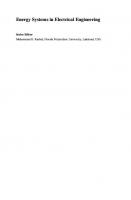Hybrid Systems and Multi-energy Networks for the Future Energy Internet 9780128191842, 0128191848
Hybrid Systems and Multi-energy Networks for the Future Energy Internet provides the general concepts of hybrid systems
376 108 22MB
English Pages 248 [239] Year 2020
Table of contents :
Front-matte_2021_Hybrid-Systems-and-Multi-energy-Networks-for-the-Future-Ene
Copyrigh_2021_Hybrid-Systems-and-Multi-energy-Networks-for-the-Future-Energy
Acknowledgmen_2021_Hybrid-Systems-and-Multi-energy-Networks-for-the-Future-E
Chapter-1---Introd_2021_Hybrid-Systems-and-Multi-energy-Networks-for-the-Fut
Chapter 1 - Introduction
1.1 - World energy
1.2 - Electricity
1.3 - Renewable energy
1.4 - Carbon dioxide emission
1.5 - Summary
References
Chapter-2---Distributed-hybrid-system-_2021_Hybrid-Systems-and-Multi-energy-
Chapter 2 - Distributed hybrid system and prospect of the future Energy Internet
2.1 - Introduction
2.2 - Topology of distributed hybrid systems
2.2.1 - Energy generation subsystem
2.2.1.1 - Fossil fuel-based energy generation
2.2.1.2 - Renewable energy generators
2.2.2 - Energy storage subsystem
2.2.2.1 - Mechanical energy storage
2.2.2.2 - Chemical energy storage
2.2.2.3 - Electromagnetic energy storage
2.2.2.4 - Thermal energy storage
2.2.3 - Energy recovery subsystem
2.2.3.1 - Heat and energy exchangers
2.2.3.2 - Low-grade heat-to-power technologies
2.2.4 - Energy end-use subsystem
2.2.4.1 - Energy demand forecasting
2.2.4.2 - Demand response programs
2.2.5 - Connection and interaction
2.3 - Scales of distributed hybrid systems
2.3.1 - Grid-connected DHS
2.3.2 - Micro-grid DHS
2.3.3 - Islanded DHS
2.4 - Distributed energy networks
2.5 - Prospect of the future Energy Internet
2.6 - Summary
References
Chapter-3---Bridging-a-bi-directional-conne_2021_Hybrid-Systems-and-Multi-en
Chapter 3 - Bridging a bi-directional connection between electricity and fuels in hybrid multienergy systems
3.1 - Introduction
3.2 - Fuel cells for energy generation
3.2.1 - Fuel cell efficiency and classification
3.2.2 - Proton exchange membrane fuel cell
3.2.3 - Alkaline fuel cell
3.2.4 - Solid oxide fuel cell
3.2.5 - Fuel cells fueled with diverse fuels
3.2.6 - Direct liquid fuel cells
3.2.7 - Direct carbon fuel cells
3.2.8 - Direct flame fuel cells
3.3 - Power-to-gas or power-to-liquid for energy storage
3.3.1 - Electrolyzers
3.3.1.1 - Energy demand and efficiency of electrolysis cells
3.3.1.2 - Alkaline electrolysis cells
3.3.1.3 - Proton exchange membrane electrolysis cells
3.3.1.4 - Solid oxide electrolysis cells
3.3.2 - Power-to-gas
3.3.2.1 - Power-to-hydrogen
3.3.2.2 - Power-to-methane
3.3.3 - Power-to-liquid
3.4 - Reversible fuel cells
3.5 - Summary
References
Chapter-4---High-efficiency-hybrid-fue_2021_Hybrid-Systems-and-Multi-energy-
Chapter 4 - High-efficiency hybrid fuel cell systems for vehicles and micro-CHPs
4.1 - Introduction
4.2 - Hybrid fuel cell/battery vehicle systems
4.2.1 - PEMFC-based fuel cell vehicle systems
4.2.1.1 - System diagram
4.2.1.2 - System weight and fuel efficiency
4.2.1.3 - Hybrid ratio
4.2.1.4 - Investment cost and fuel cost
4.2.2 - SOFC-based fuel cell vehicle systems
4.2.2.1 - Power control and management
4.2.2.2 - Driving distances
4.2.2.3 - Energy consumption and fuel efficiency
4.2.2.4 - Effect of fuel storage volume, SOFC performance and battery capacity
4.3 - Fuel cell-based micro CHP or CCHP systems
4.3.1 - Basic schematic diagram of fuel cell-based micro-CHP or CCHP systems
4.3.2 - Direct flame solid oxide fuel cell for micro-CHP or CCHP systems
4.3.3 - Costs of fuel cell-based micro-CHP systems
4.4 - Hybrid fuel cell vehicle: Mobile distributed energy system
4.5 - Summary
References
Chapter-5---Stabilization-of-intermi_2021_Hybrid-Systems-and-Multi-energy-Ne
Chapter 5 - Stabilization of intermittent renewable energy using power-to-X
5.1 - Introduction
5.2 - Power-to-gas systems
5.2.1 - Power-to-H2 for hydrogen production
5.2.1.1 - Efficiency and energy consumption
5.2.1.2 - Life-cycle green-house gas emission
5.2.2 - Power-to-syngas via H2O/CO2 co-electrolysis
5.2.3 - Power-to-methane for integrating with the natural gas networks
5.2.3.1 - PtM vs PtH
5.2.3.2 - Operating condition optimization
5.2.3.3 - Integrating the electrolyzer and methanation into one reactor
5.3 - Power-to-liquid systems
5.3.1 - Power-to-methanol
5.3.2 - Power-to-F-T liquid fuels
5.4 - Summary
References
Chapter-6---Ammonia--a-clean-and-effici_2021_Hybrid-Systems-and-Multi-energy
Chapter 6 - Ammonia: a clean and efficient energy carrier for distributed hybrid system
6.1 Introduction
6.2 - Ammonia-based energy roadmap
6.3 - Current interest and projects on ammonia-based energy vector
6.3.1 - Ammonia price
6.3.2 - Effectiveness of ammonia-based system
6.3.3 - Ammonia-based energy projects
6.4 - Hybrid systems for ammonia production
6.4.1 - System schematic and flow charts
6.4.2 - Energy efficiency and economic analysis
6.5 - Ammonia-fueled hybrid systems
6.5.1 - Ammonia-fueled engines
6.5.2 - Ammonia-to-hydrogen
6.5.3 - Indirect ammonia fuel cells
6.5.4 - Direct ammonia fuel cells
6.6 - Summary
References
Chapter-7---Power-balance-and-dynamic-s_2021_Hybrid-Systems-and-Multi-energy
Chapter 7 - Power balance and dynamic stability of a distributed hybrid energy system
7.1 - Introduction
7.2 - Dynamic system simulation platform
7.2.1 - Model library
7.2.1.1 - Fluctuant renewable energy and user loads
7.2.1.2 - Heat engines
7.2.1.3 - Burners
7.2.1.4 - Fuel cells/electrolyzers
7.2.1.5 - Batteries
7.2.1.6 - Catalytic reactors
7.2.1.7 - Heat exchangers
7.2.1.8 - Connections, dispatch and control
7.2.1.9 - System simulation platform
7.3 - Renewable power integration and power balance
7.3.1 - Evaluation of the key indicators
7.3.2 - Impact of renewable power integration
7.3.3 - Dynamic operation strategies
7.3.4 - Co-generation of electricity, heat and gas
7.4 - Novel criterion for distributed hybrid systems
7.4.1 - Application to evaluate the impact of renewable power integration
7.4.2 - Application to detect energy storage capacity
7.4.3 - Application to evaluate energy storage strategies
7.5 - Summary
References
Chapter-8---Applying-information-tech_2021_Hybrid-Systems-and-Multi-energy-N
Chapter 8 - Applying information technologies in a hybrid multi-energy system
8.1 - Why information technologies are needed?
8.2 - Block chain and energy transaction
8.3 - Energy big data and cloud computing
8.3.1 - Definition of big data and cloud computing
8.3.2 - Big data and cloud computing architecture
8.3.3 - Typical application scenarios
8.3.3.1 - Evaluation of policies and market mechanism
8.3.3.2 - Energy production prediction
8.3.3.3 - Evaluation and optimization of device performance
8.4 - Internet of Things applications
References
Further reading
Chapter-9---Application-and-potential_2021_Hybrid-Systems-and-Multi-energy-N
Chapter 9 - Application and potential of the artificial intelligence technology
9.1 - Smart energy
9.2 - Prediction for energy Internet
9.3 - Control and optimization based on artificial algorithm
9.4 - Swarm intelligence for complex energy networks
References
Index_2021_Hybrid-Systems-and-Multi-energy-Networks-for-the-Future-Energy-In
Front-matte_2021_Hybrid-Systems-and-Multi-energy-Networks-for-the-Future-Ene
Copyrigh_2021_Hybrid-Systems-and-Multi-energy-Networks-for-the-Future-Energy
Acknowledgmen_2021_Hybrid-Systems-and-Multi-energy-Networks-for-the-Future-E
Chapter-1---Introd_2021_Hybrid-Systems-and-Multi-energy-Networks-for-the-Fut
Chapter 1 - Introduction
1.1 - World energy
1.2 - Electricity
1.3 - Renewable energy
1.4 - Carbon dioxide emission
1.5 - Summary
References
Chapter-2---Distributed-hybrid-system-_2021_Hybrid-Systems-and-Multi-energy-
Chapter 2 - Distributed hybrid system and prospect of the future Energy Internet
2.1 - Introduction
2.2 - Topology of distributed hybrid systems
2.2.1 - Energy generation subsystem
2.2.1.1 - Fossil fuel-based energy generation
2.2.1.2 - Renewable energy generators
2.2.2 - Energy storage subsystem
2.2.2.1 - Mechanical energy storage
2.2.2.2 - Chemical energy storage
2.2.2.3 - Electromagnetic energy storage
2.2.2.4 - Thermal energy storage
2.2.3 - Energy recovery subsystem
2.2.3.1 - Heat and energy exchangers
2.2.3.2 - Low-grade heat-to-power technologies
2.2.4 - Energy end-use subsystem
2.2.4.1 - Energy demand forecasting
2.2.4.2 - Demand response programs
2.2.5 - Connection and interaction
2.3 - Scales of distributed hybrid systems
2.3.1 - Grid-connected DHS
2.3.2 - Micro-grid DHS
2.3.3 - Islanded DHS
2.4 - Distributed energy networks
2.5 - Prospect of the future Energy Internet
2.6 - Summary
References
Chapter-3---Bridging-a-bi-directional-conne_2021_Hybrid-Systems-and-Multi-en
Chapter 3 - Bridging a bi-directional connection between electricity and fuels in hybrid multienergy systems
3.1 - Introduction
3.2 - Fuel cells for energy generation
3.2.1 - Fuel cell efficiency and classification
3.2.2 - Proton exchange membrane fuel cell
3.2.3 - Alkaline fuel cell
3.2.4 - Solid oxide fuel cell
3.2.5 - Fuel cells fueled with diverse fuels
3.2.6 - Direct liquid fuel cells
3.2.7 - Direct carbon fuel cells
3.2.8 - Direct flame fuel cells
3.3 - Power-to-gas or power-to-liquid for energy storage
3.3.1 - Electrolyzers
3.3.1.1 - Energy demand and efficiency of electrolysis cells
3.3.1.2 - Alkaline electrolysis cells
3.3.1.3 - Proton exchange membrane electrolysis cells
3.3.1.4 - Solid oxide electrolysis cells
3.3.2 - Power-to-gas
3.3.2.1 - Power-to-hydrogen
3.3.2.2 - Power-to-methane
3.3.3 - Power-to-liquid
3.4 - Reversible fuel cells
3.5 - Summary
References
Chapter-4---High-efficiency-hybrid-fue_2021_Hybrid-Systems-and-Multi-energy-
Chapter 4 - High-efficiency hybrid fuel cell systems for vehicles and micro-CHPs
4.1 - Introduction
4.2 - Hybrid fuel cell/battery vehicle systems
4.2.1 - PEMFC-based fuel cell vehicle systems
4.2.1.1 - System diagram
4.2.1.2 - System weight and fuel efficiency
4.2.1.3 - Hybrid ratio
4.2.1.4 - Investment cost and fuel cost
4.2.2 - SOFC-based fuel cell vehicle systems
4.2.2.1 - Power control and management
4.2.2.2 - Driving distances
4.2.2.3 - Energy consumption and fuel efficiency
4.2.2.4 - Effect of fuel storage volume, SOFC performance and battery capacity
4.3 - Fuel cell-based micro CHP or CCHP systems
4.3.1 - Basic schematic diagram of fuel cell-based micro-CHP or CCHP systems
4.3.2 - Direct flame solid oxide fuel cell for micro-CHP or CCHP systems
4.3.3 - Costs of fuel cell-based micro-CHP systems
4.4 - Hybrid fuel cell vehicle: Mobile distributed energy system
4.5 - Summary
References
Chapter-5---Stabilization-of-intermi_2021_Hybrid-Systems-and-Multi-energy-Ne
Chapter 5 - Stabilization of intermittent renewable energy using power-to-X
5.1 - Introduction
5.2 - Power-to-gas systems
5.2.1 - Power-to-H2 for hydrogen production
5.2.1.1 - Efficiency and energy consumption
5.2.1.2 - Life-cycle green-house gas emission
5.2.2 - Power-to-syngas via H2O/CO2 co-electrolysis
5.2.3 - Power-to-methane for integrating with the natural gas networks
5.2.3.1 - PtM vs PtH
5.2.3.2 - Operating condition optimization
5.2.3.3 - Integrating the electrolyzer and methanation into one reactor
5.3 - Power-to-liquid systems
5.3.1 - Power-to-methanol
5.3.2 - Power-to-F-T liquid fuels
5.4 - Summary
References
Chapter-6---Ammonia--a-clean-and-effici_2021_Hybrid-Systems-and-Multi-energy
Chapter 6 - Ammonia: a clean and efficient energy carrier for distributed hybrid system
6.1 Introduction
6.2 - Ammonia-based energy roadmap
6.3 - Current interest and projects on ammonia-based energy vector
6.3.1 - Ammonia price
6.3.2 - Effectiveness of ammonia-based system
6.3.3 - Ammonia-based energy projects
6.4 - Hybrid systems for ammonia production
6.4.1 - System schematic and flow charts
6.4.2 - Energy efficiency and economic analysis
6.5 - Ammonia-fueled hybrid systems
6.5.1 - Ammonia-fueled engines
6.5.2 - Ammonia-to-hydrogen
6.5.3 - Indirect ammonia fuel cells
6.5.4 - Direct ammonia fuel cells
6.6 - Summary
References
Chapter-7---Power-balance-and-dynamic-s_2021_Hybrid-Systems-and-Multi-energy
Chapter 7 - Power balance and dynamic stability of a distributed hybrid energy system
7.1 - Introduction
7.2 - Dynamic system simulation platform
7.2.1 - Model library
7.2.1.1 - Fluctuant renewable energy and user loads
7.2.1.2 - Heat engines
7.2.1.3 - Burners
7.2.1.4 - Fuel cells/electrolyzers
7.2.1.5 - Batteries
7.2.1.6 - Catalytic reactors
7.2.1.7 - Heat exchangers
7.2.1.8 - Connections, dispatch and control
7.2.1.9 - System simulation platform
7.3 - Renewable power integration and power balance
7.3.1 - Evaluation of the key indicators
7.3.2 - Impact of renewable power integration
7.3.3 - Dynamic operation strategies
7.3.4 - Co-generation of electricity, heat and gas
7.4 - Novel criterion for distributed hybrid systems
7.4.1 - Application to evaluate the impact of renewable power integration
7.4.2 - Application to detect energy storage capacity
7.4.3 - Application to evaluate energy storage strategies
7.5 - Summary
References
Chapter-8---Applying-information-tech_2021_Hybrid-Systems-and-Multi-energy-N
Chapter 8 - Applying information technologies in a hybrid multi-energy system
8.1 - Why information technologies are needed?
8.2 - Block chain and energy transaction
8.3 - Energy big data and cloud computing
8.3.1 - Definition of big data and cloud computing
8.3.2 - Big data and cloud computing architecture
8.3.3 - Typical application scenarios
8.3.3.1 - Evaluation of policies and market mechanism
8.3.3.2 - Energy production prediction
8.3.3.3 - Evaluation and optimization of device performance
8.4 - Internet of Things applications
References
Further reading
Chapter-9---Application-and-potential_2021_Hybrid-Systems-and-Multi-energy-N
Chapter 9 - Application and potential of the artificial intelligence technology
9.1 - Smart energy
9.2 - Prediction for energy Internet
9.3 - Control and optimization based on artificial algorithm
9.4 - Swarm intelligence for complex energy networks
References
Index_2021_Hybrid-Systems-and-Multi-energy-Networks-for-the-Future-Energy-In

- Author / Uploaded
- Yu Luo
- Yixiang Shi
- Ningsheng Cai






![Energy Internet: Systems and Applications [1st ed.]
9783030454524, 9783030454531](https://ebin.pub/img/200x200/energy-internet-systems-and-applications-1st-ed-9783030454524-9783030454531.jpg)


